Christmas Trilogy 2021 Part 3: Don’t throw the baby out with the bathwater
From the beginning of European astronomy, sometime during the third millennium BCE in the Fertile Crescent, all the way down to the middle of the seventeenth century CE, nearly all active astronomers were practicing astrologers. In the Early Modern Period almost without exception the astronomers, who contributed to the birth of the new heliocentric astronomy were also astrologers, who believed in celestial influence. Even Galileo, who is falsely hailed as the founder of modern science, was a practicing astrologer and all the evidence points to the fact that he believed in it. So, what about Johannes Kepler? Kepler is a fascinating case, as for large parts of his life, he actively practiced an astrology that he didn’t believe in but believed in an astrology that nobody practiced.
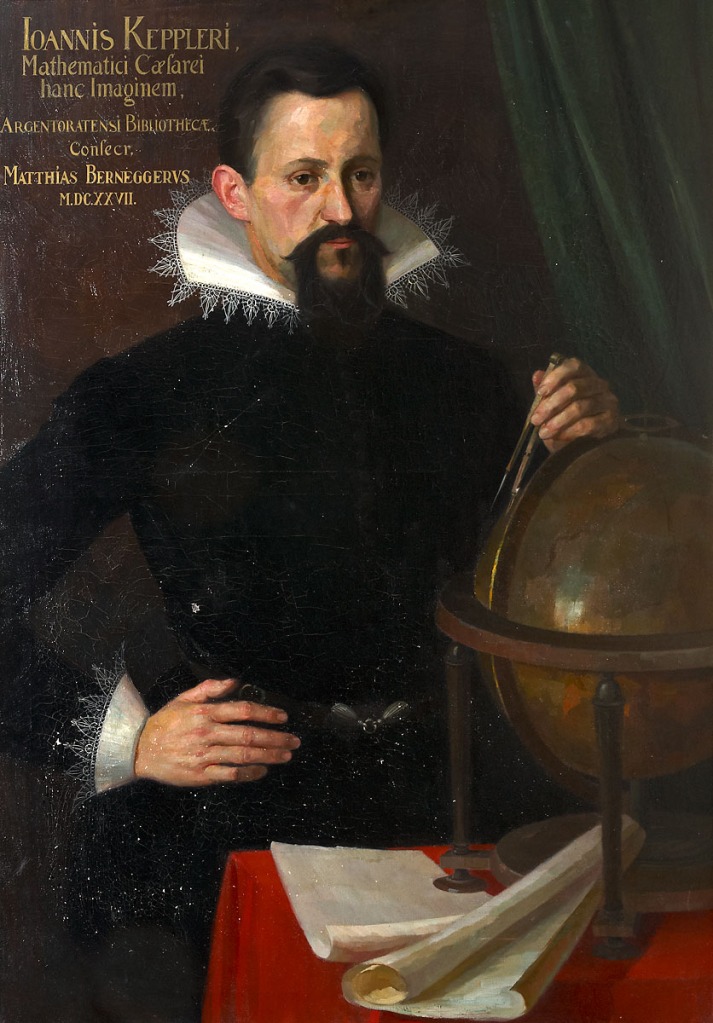
Kepler obviously grew up in a culture, where astrology was part of everyday life and he seemed to accept it as did almost everyone. A biographical sketch of himself and his family in which he famously describes himself as a lap dog, Ich habe in jeder Hinsicht die Natur eines Hundes. Ich bin wie ein verwöhntes Haushündchen (I have in every respect the nature of a dog. I am like a pampered lapdog). Is full of scattered astrological references. For example:
I am, however, not arrogant and contemptuous toward public opinion, but tend, admittedly, to rough speech.
When, for example, Saturn looks towards Mercury, it gets cold, so the mind droops, when Jupiter looks towards Mercury, it causes everything to become damp and fervid. There everything pushes to acquisitiveness, here to jealousy…
My father Heinrich was born on 19 January 1547, Saturn ruined everything, produced a heinous, rough, argumentative, and in the end, man of evil death.
These astrological references are, however, more than somewhat unusual, as they only refer to the influence of planets, which I will explain later. Kepler’s life was not only imbued with astrology on a daily level, astrology, also played a significant role in the various stages of his career.
When he left Tübingen University in 1594, it was to take up the position of mathematics teacher at the Protestant school in Graz. However, this job also included the position of district mathematicus, one of whose obligations was to produce the annual astrological writing calendar and prognostication for the district. The writing calendar provided the yearly astronomical and astrological data to enable physicians and barber-surgeons to practice their iatromathematics or astro-medicine, to make diagnoses and to know when the good and bad days for applying bloodletting, cupping, and purging were. Although onerous, this undertaking was a good additional source of income. The calendar writer was a paid official, but his calendars and prognostications were sold commercial, with the normal practice of the printer-publisher and the calendar writer sharing the not insubstantial profits.

Because he successful forecast a severe winter, Turkish military advances, and peasant uprisings in his very first prognostications in Graz in 1595, he was a big hit establishing his reputation as an excellent astrologer. This would later prove helpful in a difficult situation. In 1598, the Catholic authorities in Graz, as part of the Counter Reformation, forced all the Protestants in the district to either convert to Catholicism or leave. Kepler was granted a special dispensation, not because he was a schoolteacher, the Protestant school was closed down, but because of his respected status as district astrologer. A year later even this status could not protect him, and he was forced to leave Graz for Prague.
Initially in Prague, Kepler was Tycho Brahe’s colleague and quasi-assistant, but within a year he had replaced him as Imperial Mathematicus. In this post he was free to carry on his astronomical research, but his principal function was that of court astrologer. He was required to provide and interpret horoscopes for the Emperor Rudolf II, who believed strongly in all forms of esotericism.

He also continued his function as producer of writing calendars and prognostications. When Rudolf lost his throne to his brother Matthias, Kepler was able to keep his title of Imperial Mathematicus, but was required to leave Prague. He now landed in Linz as district mathematicus, with, once again, district astrologer as one of his main functions.

In 1626, the Thirty Years War forced Kepler and his family to leave Linz and to seek refuge and new employment elsewhere. In 1628, he found new employment as court astrologer to the commander of the Catholic forces Albrecht von Wallenstein (1583–1634).

This was not the first time that Wallenstein, who was obsessed with astrology, had employed Kepler’s services as an astrologer. In 1608, a physician by the name of Stromair approached Kepler in Prague with the request to cast a horoscope for an anonymous noble lord. Because Stromair was a reputable physician, and probably because the payment offered was generous, Kepler always had money problems, he accepted the commission.
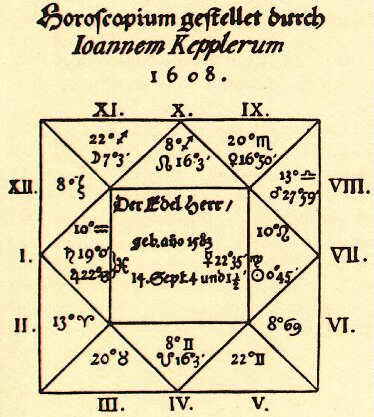
Although apparently anonymous, it appears that Kepler knew, who the subject of the horoscope was and in his detailed analysis drew a very accurate portrait of the Catholic grandee. Wallenstein was very impressed and because the prognostications in the horoscope only ran until 1625, in that year he commissioned Kepler to write an extension.
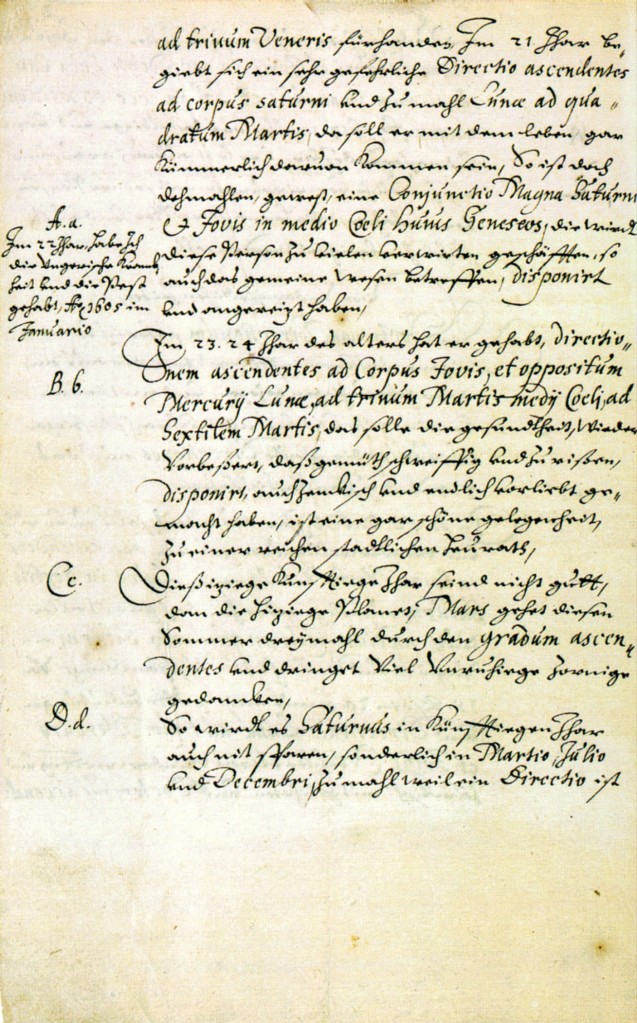
The new prognostication contained a non-specific warning for the beginning of the year 1634. Wallenstein was murdered on 25 February 1634. Kepler did not live to see the fulfilment of his prognostication having died in 1630.

Given that astrology basically financed Kepler’s existence for nearly all of his adult life, it might come as something as a surprise that he didn’t actually believe in conventional horoscope astrology. However, before anybody jumps to the conclusion that he did it just for the money, he did believe very strongly in celestial influence the basic premise on which astrology was based, an apparent contradiction.
Kepler rejected nearly the whole apparatus on which traditional Western astrology was based. He thought that the division of the ecliptic, the apparent path of the Sun around the Earth, into the twelve sun signs was purely arbitrary and had no basis in reality. He also rejected all the various schemes for dividing the zodiac into houses, for the same reason. One might ask, if Kepler rejected the whole apparatus, how did he cast so many horoscopes in his life? Being a fully trained astronomer, he could, of course, talk the talk, but he, as he tells us, filled out his interpretations with a mixture of common sense, shrewd observation, and applied psychology. Was he cheating his clients? He wasn’t doing astrology according to the book, but people were satisfied with his horoscopes.
Although he rejected the conventional astrology, as already stated, Kepler very much believed in celestial influence and it in fact was an integral part of his entire scientific philosophy. Kepler believed that the planets radiated influence and only the planets, not the stars, not the zodiac signs, or the houses. Moreover, he believed that a single planet could not exercise influence but only two or more planets in combination, when they stood on the ecliptic at specific geometrical angles to each other, 90°, 180°, 60° etc., the so-called aspects.
Kepler wrote several publications explaining his new astrological model, the earliest De Fundamentis Astrologiae Certioribus (Concerning the More Certain Fundamentals of Astrology) published in 1601, as a forward to his annual prognostications.
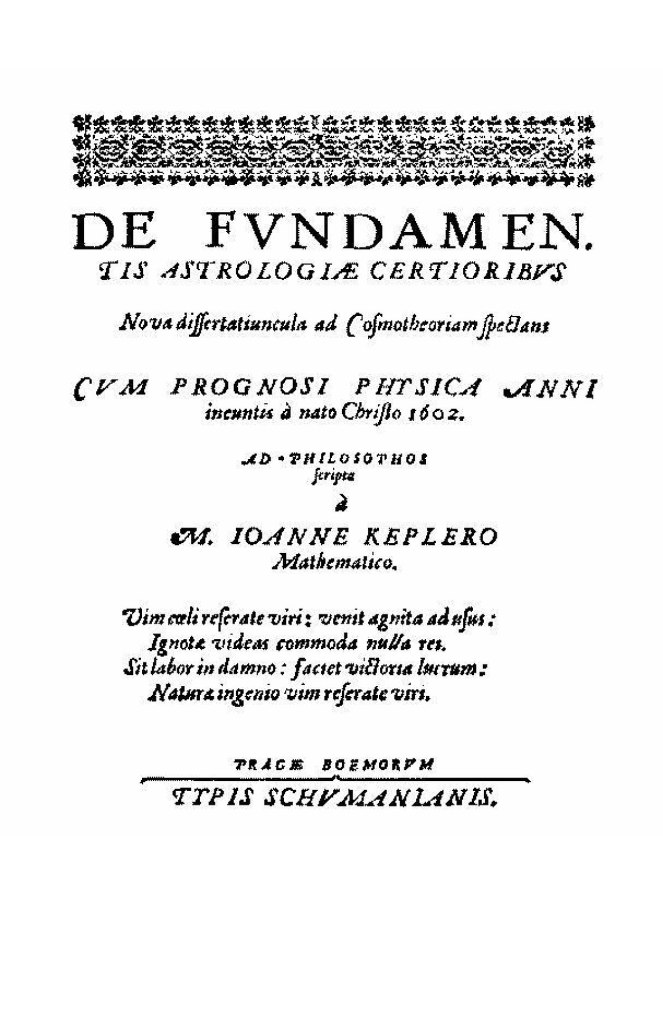
Kepler astrology was not determinist, it only indicated tendencies and not certainties. His biggest presentation of his views on astrology came about as a result of a dispute over astrology with the German physician and astrologer, Helisäus Röslin (1545–1616), physician-in-ordinary to the count palatine of Veldenz and the count of Hanau-Lichtenberg in Buchsweiler in Alsace. The two of them had know each other since their university days.
Röslin wrote an astrological interpretation of the nova observed in Europe in 1604. Kepler took Röslin to task, in his own publication on the nova De Stella Nova in Pede Serpentarii (On the New Star in the Foot of the Serpent Handler) in 1606.
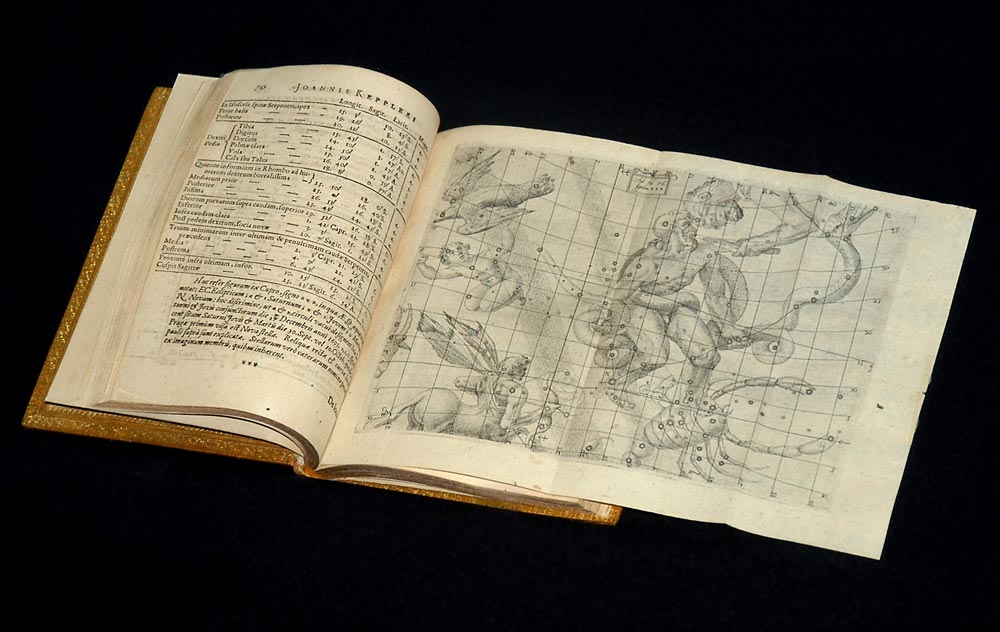
Röslin responded with his Discurs von heutigen Zeit Beschaffenheit, which Kepler countered with Antwort auff Röslini Discurs, in which he also defended his heliocentric world view against Röslin’s Tychonic system. At the same time as Röslin published his Discurs von heutigen Zeit Beschaffenheit,dedicating it to Margrave Georg Friedrich von Baden, this noble’s physician-in-ordinary, Philip Feselius also dedicated to him his Discurs von de Astrologia iudiciaria. This was a total attack on astrology, which Feselius rejected completely.
Kepler now re-entered the debated with a book, also dedicated to Margrave Georg Friedrich, Tertius Intervenies, das ist Warnung an etliche Theologos, Medicos, vnd Philosophos, sonderlich D. Philippum Feselium, dass sie bey billicher Verwerffung der Sternguckerischen Aberglauben nicht das Kindt mit dem Badt ausschütten vnd hermit iher Profession vnwissendt zuwider handlen (1609). (Tertius Interveniens, that is warning to some theologians, medics and philosophers, especially Dr Philip Feselius, that they in cheap condemnation of the stargazer’s superstition do not throw out the baby with the bath and hereby unknowingly act contrary to their profession). Tertius Interveniens means Third-party interventions.
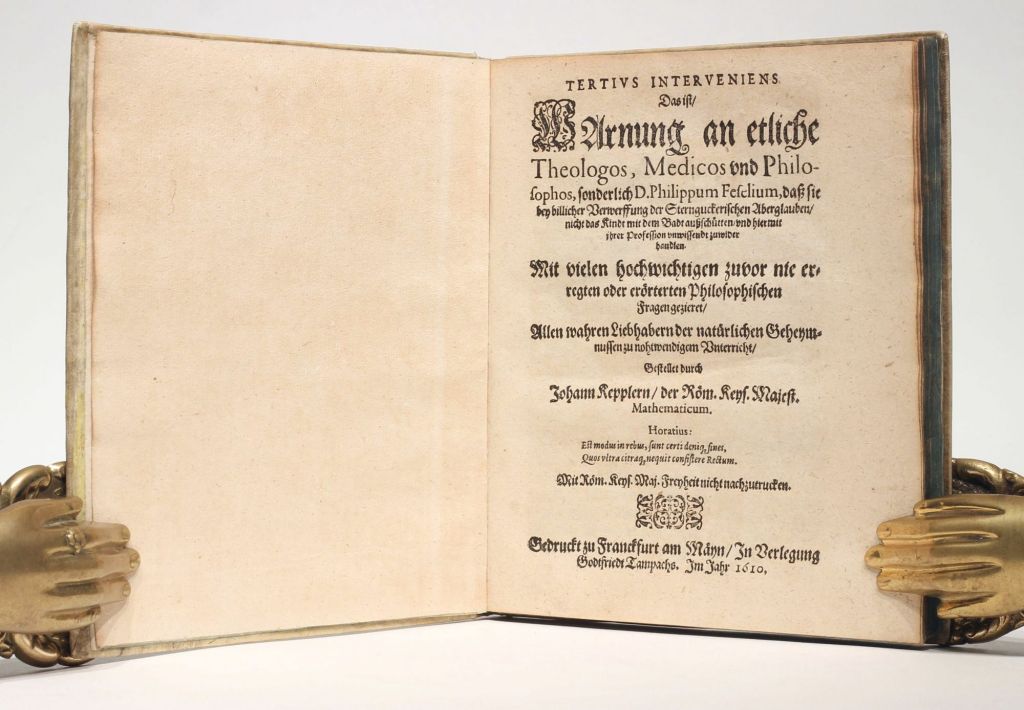
The Tertius Intervenies is a quite extraordinary publication. In 140 numbered entries that vary between a short paragraph and several pages Kepler presents a complete picture of how he sees his astronomy, astrology, natural philosophy, geometry, harmony, and theology as an integrated system. Kepler comes out swinging:
No one should consider unbelievable that there could come out of astrology foolishness and godlessness also useful cleverness and holiness out of unclean slimy substance also a snail, mussel, oyster or eel useful for eating out of the great heap of caterpillar dirt also a silk spinner and finally that out of evil-smelling dung also perhaps a good little grain yes a pearly or golden corn could be scraped for and found by an industrious hen
In some senses the Tertius Intervenies in one of the most complete presentations of Kepler’s world of thought, but because it’s in German and not Latin and because it is purely polemical and not scientific it generally gets ignored, when people discuss Kepler’s contributions to the history of science.
In a quite extraordinary paper the historian of Early Modern science, Edward Rosen, once argued that Kepler was foolish enough as a young man to practice astrology but as he matured, he abandoned this foolishness. This is fascinating, as in the fourth book of his Harmonices mundi libri V, published in 1619, Kepler repeats the basic contents of his Tertius Intervenies, but this time more technically, that is within the context of his geometrical harmony theory. Kepler remained a convinced astrologer his whole life, but he was a reforming astrologer, who rejected nearly all of the astrology practiced by others in his times.
The first time I came across the Tertius Intervenies, I was fascinated by his usage of the expression “do not throw out the baby with the bath(water),” as this is a common phrase that is still in use, and I hadn’t thought of it being that old. I recently discovered that when Kepler used it, it was roughly a hundred years old and German in origin. The earliest known instance of the proverb, in print, “to throw the baby out with the bathwater,” is in the Narrenbeschwörung (Appeal to Fools) by Thomas Murner (1475–1537), a humanist satirist, published in Straßburg in 1512.
